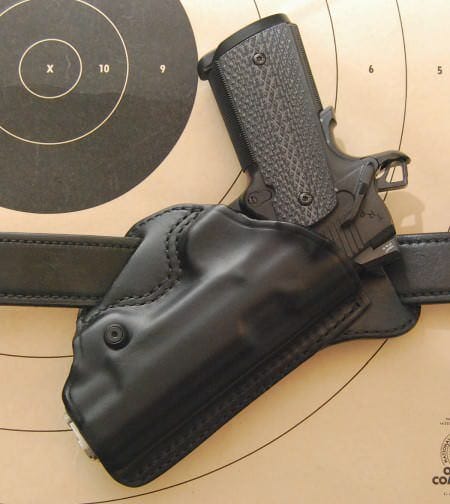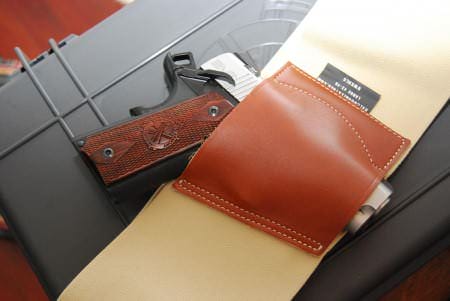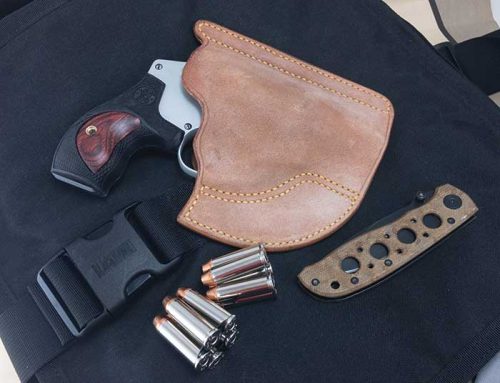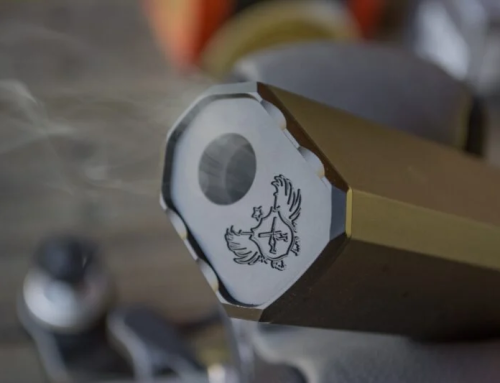
How do you choose which holster is right for you?
If you listen to the internet, you might think that belt carry is the only sensible way to carry a gun. Any other way sucks on general principle, will get you killed, or result in Pluto plummeting from the sky into western Kansas. That’s probably OK though, considering Pluto isn’t a real planet anymore.
I like to be more understanding. While I do believe belt carry is probably the best all-around option, assuming you can, it’s simply not feasible for all people all of the time. Women may need to wear a dress instead of pants. Men may spend most of their day sitting or in a vehicle. Men and women may have work dress codes that make belt carry difficult or impossible. There are a million reasons why traditional belt carry may not be an option at all times.
Sometimes you just have to accept other carry options due to your circumstances. You might have to adopt a carry method that is a little slower or that offers more difficult access to your gun. Might that be less than ideal? Yes. Is it better than not carrying at all? Yes.
For example, if your work environment forces you to carry very deeply concealed, you might choose to carry my gun in an undershirt holster rather than not carry at all. Is that as fast as belt carry? No. Is undershirt carry better than not carrying at all? Yes. Could it make a difference in a surprise mugging? Maybe not. Will it help if you’re sitting at your desk and hear gunshots down the hall? Yes.
With that said, let’s look at a number of carry styles that may work for you, based on your particular situation. Note that I’m not including off body carry options like purses, packs or day planners. While I understand these might be necessary for certain scenarios, I would always choose a different non-traditional carry method. I prefer using a carry method that keeps my gun on my body, not in a bag that could be left unattended or taken from me. But that’s my personal decision and your mileage may vary.
Belt Carry
For a single carry method, you’ve actually got a number of choices. There are inside and outside the waistband options. You can choose different locations on your belt line ranging from cross draw to appendix to behind the hip.
For inside-the-waistband carry, my number one pick is the Galco KingTuk. The large leather panel of the hybrid design stabilizes your gun and spreads the weight around. The use of Kydex for the gun pocket keeps the whole rig as thin as possible and your gun securely in place. For small to medium-sized guns, check out the super comfortable N82 Tactical holsters.
For outside carry, I like a good pancake-style holster. The large area and spread-out belt loops offer plenty of stability. One of my favorites is the Blackhawk! Check Six. It’s designed to be worn behind the hip and is heavily canted. This minimizes the length of cover garment you need to cover it up. If you prefer a less aggressive cant angle, take a look at the Mitch Rosen 5JR-EXP. If you want the convenience of easy removal, try the Galco Side Snap Scabbard. You can put it on and take it off without removing your belt.
Body Carry
There are a number of ways to carry a gun around your torso or belly area. The standard Belly Band is amazingly versatile if you invest some time experimenting with different placement locations while using an unloaded gun. You can wear it low, so it acts like a tuckable inside-the-waistband holster. The best part? When you tuck in a shirt or blouse, there are no telltale clips to give you away. You can also try wearing it higher, underneath a shirt or blouse. Last, but not least, a belly band can make a good cross draw solution.
Compression shirts for men and women feature an elastic holster under the arm. While harder and slower to access, concealment and gun security are both excellent. Your gun is completely hidden under a shirt and your arm aids in total concealment. If you evaluate this method, you must practice – a lot – with an unloaded gun. Drawing from under a pullover or buttoned shirt is a skill to be learned. Check out models from 5.11 Tactical and Undertech Undercover.









Nice coverage, but women have another option. Well, so do men, but not many will use it. It’s called a purse and it’s not necessary to spend $75 and up for one. It simple needs to be secure with a dedicated concealed pouch. Ideally, the sling style (crossed over the body) is best, since hands are free, but as long as one is comfortable and the firearm is secure, a purse is a great option.
Off body carry is not a good idea, how are you gonna defend yourself when your purse, backpack, or briefcase is snatched and in the hands of a criminal. Most instructors I’ve talked to say the only safe way is on body carry because even if the creep has your bag you still are armed incase he wants more than your bag.
Pluto plummeting into western Kansas? I guess I’d have to organize a few posses to break it up before it landed by firing heavy doses of lead at it to make it veer off course into Colorado. They’re stuck with minimal capacity magazines out there, so we’d have the edge on them. That’d pay them back for stealing the water from the Arkansas before it hits the state line, leaving us with a dry riverbed most of the time. It’s actually a novelty to see water in the Arkansas at Dodge City.
Seriously, I’ve been trying several types of on-the-body carry such as a belly band, in-pocket holsters, waist-band holsters, undershirt holsters, etc. One idea for wearing the inside-the-waistband holster is that you can the clip(s) (depending on the model) behind a phone holster, so you could still wear your shirt tucked in. I think the resulting tautness of the shirt would make it print more though when it’s tucked in. I like a belly band and keep on shirt button undone to facilitate an easier draw. I wear it for cross-draw and it also has a strap for better security. The waistband holsters present potential dilemmas for when you answer the call of nature.
I recommend practice runs with any concealed carry method using an unloaded weapon to learn what pitfalls that each method might present, and figure out a work-around or try a different method altogether. What works for one person doesn’t work for everyone, but their insights and experiences can still be helpful I’d thought an ankle holster might be my choice, but most jeans fit me too tight in the leg to be able to draw well at all. Different guns will of course have different requirements, since an LCP will provide many more carry options than a 1911, but some folks need a weapon with a larger grip, and the LCP wouldn’t cut it for them. Some larger phone holsters can double as a CCL holster. I remember someone used to make a derringer-type pistol that came with a wallet/holster with a hole in one side to access the trigger. A mugger asks for your wallet, and you could draw the wallet and give him both barrels.
The legalities are even complicated by what you are carrying. For instance, you can get the mini-revolver in .22 or .22 magnum and they fit into a belt buckle. They also made it in a black powder version. Technically, the BP firearms aren’t considered as firearms under the Gun Control Act of 1968 or its later version, and if you have your shirt tail hiding it, it’s still concealed. If you are carrying it open, it’s not a concealed weapon, but it’s not going to be obvious to most that it’s BP. Even with the regular versions, it’s not obvious to most of the gun-ignorant public that it’s even a real gun, rather than just a belt buckle featuring a gun shape. Most people don’t blink an eye when you wear it in public, but you’d still probably want to have it covered, if not to conform to policy of where you are, at least for the same reasons you want to carry concealed in the first place, to avoid being a primary target if something goes down.
Remember that situational awareness is also a big consideration, and your carry method can vary accordingly. For instance, you can have that handy little belt holster that doesn’t look look like a gun holster until you put a gun in it, and carry in an undershirt holster. You leave your office for the day, stop somewhere private and transfer to the more draw-ready holster as your potential situational needs change. The weather even plays a part in how you can carry it without it being obvious, since you wear heavier clothes in the winter, and those can conceal better. Mainly, it takes planning and practice to work out details for safe and well-concealed carry. And then don’t give it away be patting it all the time to make sure it’s still there. Practice on not having a “tell” so you don’t don’t develop those bad habits. Stay calm and carry, safely.